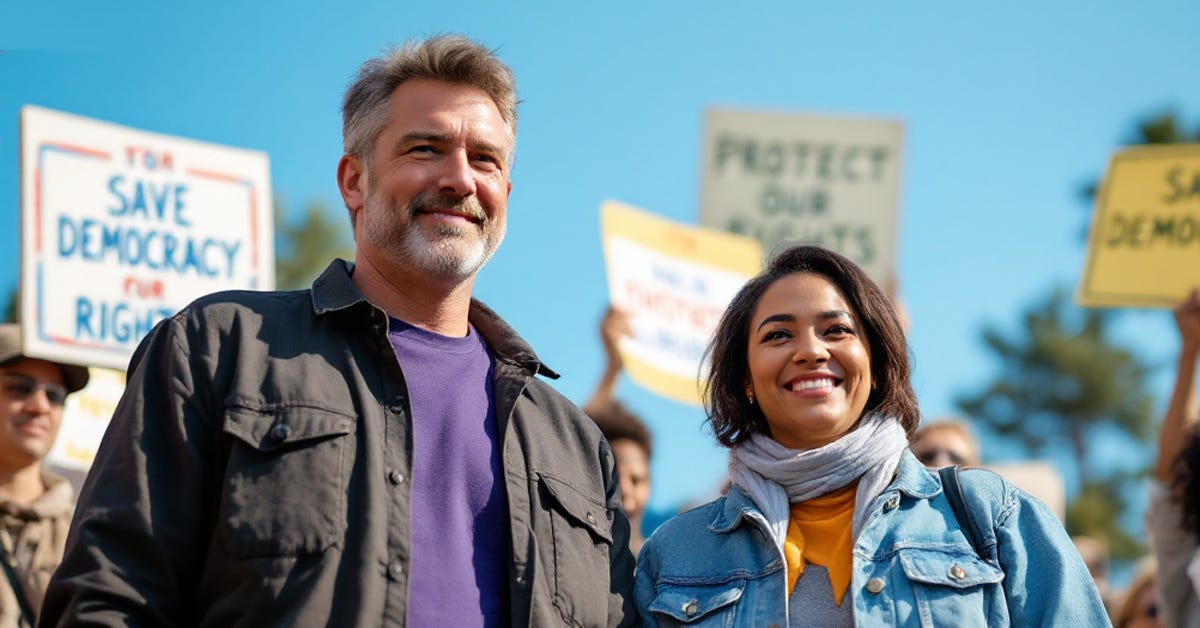A Liberal's Guide to Protesting: Effective Strategies for Safety and Action
How To Safely Stand Up for Justice
In an era where our democratic institutions face unprecedented challenges, peaceful protest remains a powerful tool for change.
It’s more important than ever to take action as former President Trump attempts to reassert his authoritarian agenda—a regressive mix of policies rooted in greed, the pursuit of power, and bigotry.
Protesting is about more than resisting his policies. It’s about standing up for a future rooted in equality, justice, and compassion.
As we face these challenges, it's crucial to protest safely, effectively, and with respect for our communities.
Here's your comprehensive guide to making your voice heard while keeping yourself and others safe.
Don’t miss what’s next—subscribe now for more sharp insights and unapologetic truth.
Know Your Rights: The First Amendment Is Your Shield
Before you hit the streets, arm yourself with knowledge. The First Amendment is your strongest ally, protecting your right to speak out, assemble peacefully, and petition the government. Here's what you need to know:
Freedom of Speech: Your right to express yourself, even if your message is unpopular or controversial, is protected. This includes spoken words, written messages, and symbolic speech like protests and demonstrations.
Right to Assemble: You have the constitutional right to gather in public spaces like streets, sidewalks, and parks to make your voice heard.
Freedom to Petition: You can express your grievances to the government without fear of retaliation. It's not just a right; it's a cornerstone of democracy.
Remember, while these rights are robust, they're not absolute. Local governments can impose some regulations for public safety, but these must be content-neutral and narrowly tailored. Be aware of any permit requirements for large gatherings, especially those that might block traffic or require street closures.
Protesting Safely: Gear Up for Change
Safety should be your top priority. Here's how to prepare:
Dress Smart: Wear comfortable, non-distinctive clothing that covers your skin. This protects you from chemical irritants and makes it harder for you to be singled out.
Protect Your Identity: Consider wearing a hat, sunglasses, and a face mask. It's not just about COVID-19; it's about shielding yourself from surveillance.
Pack Essentials: Bring water (for drinking and rinsing eyes), energy-rich snacks, a fully charged phone with a power bank, and a small first aid kit.
Digital Defense: Encrypt your phone and use secure messaging apps like Signal. Your digital privacy matters too!
Protest Respectfully: The Power of Non-Violent Resistance
Peaceful protest is not just morally right; it's strategically smart. Here's how to make your protest both respectful and effective:
Non-Violent Techniques: Employ methods like public speeches, petitions, and symbolic acts. These can be incredibly powerful in raising awareness and gaining support.
Creative Expression: Use art, humor, and creativity in your protest. It makes your message more relatable and memorable.
De-escalation: Train yourself in de-escalation techniques. Maintain a calm demeanor, use non-threatening body language, and engage in dialogue when possible.
Media Engagement: Use media to amplify your message. Engage with journalists and use social media platforms strategically.
Community Safety: We're All In This Together
Remember, your protest is part of a larger community. Here's how to keep everyone safe:
Coordinate with Authorities: Engage in cooperative planning with local law enforcement to ensure public safety. This doesn't mean compromising your message; it means creating a safer environment for everyone.
Use Police Liaisons: If possible, appoint a liaison to communicate with law enforcement. This person can clarify the group's non-violent intentions and maintain communication if tensions arise.
Plan Your Route: Consider the impact on traffic and local businesses. A well-planned route minimizes disruption and keeps the focus on your message.
Buddy System: Attend protests with a friend or group. Look out for each other and have a plan in case you get separated.
Stay Informed: Follow the lead of experienced organizers and stay vigilant about your surroundings.
Additional Resources for Protesters
For more information on your rights and how to protest effectively, check out these resources:
Human Rights Campaign: Tips for Preparedness, Peaceful Protesting, and Safety.
Natural Resources Defense Council: How To Protest Safely.
Conclusion: Fighting for Justice, Together
Peaceful protest is not just a right; it's a responsibility. By protesting safely, respectfully, and with community safety in mind, we not only protect ourselves but also strengthen the very democratic principles we're fighting to uphold.
In the face of Trump's attempts to revive policies rooted in division and oppression, peaceful activism becomes more than a political act—it becomes a moral imperative.
As we rise to this challenge, let’s draw inspiration from the words of the late John Lewis: "Never, ever be afraid to make some noise and get in good trouble, necessary trouble."
Let’s make our voices heard, but let’s do it in a way that reflects the change we want to see in the world. Together, we can fight for a future where justice and equality prevail.
Love snark and truth in equal measure? Subscribe now to join a growing community of readers who refuse to let hypocrisy slide. It’s free to sign up, and paid subscribers get bonus perks like free eBooks—because calling out nonsense should come with rewards.
Thank you for supporting bold, unapologetic journalism. Together, we’re cutting through the noise and fighting for a future built on truth and justice!








Thank you very much
Thanks for the great advice